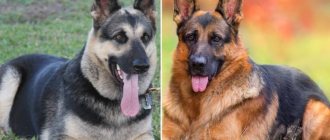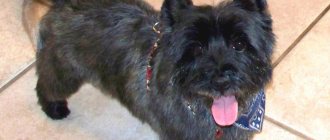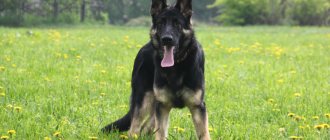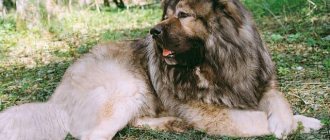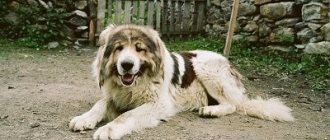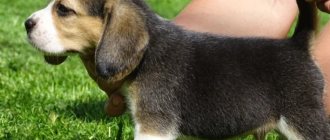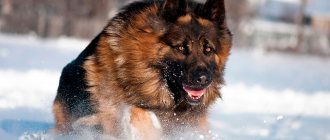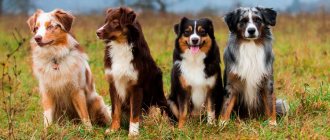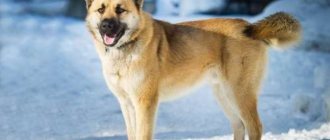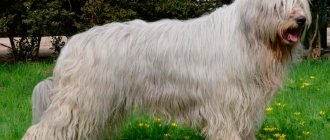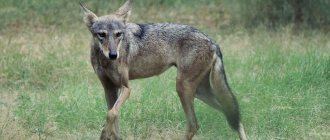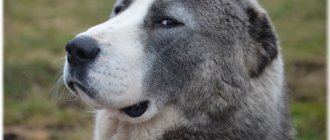The owner of a four-legged pet is always interested in how correctly his pupil is developing. Therefore, the question of how old a dog of this breed grows is not idle. Every owner also needs to know how many grams a puppy should gain monthly and how many centimeters it should grow. The pet's parameters must match the average.
How old do East European Shepherds grow?
The East European Shepherd grows most actively during the first year of life. The dog’s appearance changes, its proportions are formed, it matures and gains body weight. The animal also grows in height. Moreover, from the very first days, male dogs differ from girls of the same age - they are larger, more powerful.
Until seven or eight months, the most noticeable thing is how their height and weight increase. A table of animal growth during different periods of life will help you analyze whether this process is happening correctly in your pet. It shows the weight of the VEO puppy by month.
At 1 year old, the dog already looks quite grown up. She acquires the weight of an adult VEO, which should not change for the rest of her life.
Deviations of parameters indicate physiological changes in the body. In bitches this happens during pregnancy, feeding puppies, and childbirth. Sometimes a slight decrease in weight is observed due to ignored estrus.
Height and weight are the main indicators of puppy development
Important! After spaying and neutering, pets may begin to gain excessive weight. There are known cases of obesity after surgery.
If the weight of the East European Shepherd changes without an objective reason, this indicates:
- disease;
- incorrect content.
However, even after a year, East European Shepherds are still growing, as the body is being formed. They become adults at 2 years old. Some individuals grow up to 3 years, enlarging their chest.
How to choose the right puppy?
Pedigree puppies are sold in single-breed nurseries that specialize in breeding East European Shepherds. Due to their low prevalence, purebred individuals are quite difficult to find, so you should only contact trusted organizations that are registered with the RKF and have earned a good reputation.
The choice is complicated by the similarity of East European Shepherd puppies with German Shepherd babies - up to two months they look almost the same. To avoid disappointment, you must ask the breeder to show the parents' documents. Animals must also have a veterinary passport and registration certificate.
Healthy puppies are active, curious, alert and cheerful. Their coat shines, and their gaze expresses interest. If the baby does not respond to external stimuli, he may be seriously ill. A conscientious breeder will give detailed instructions on the volume and diet, and also answer all questions about keeping and raising a shepherd dog.
On a note. For security purposes, it is better to choose the largest puppies.
In Moscow, purebred puppies can be purchased in nurseries:
VEO puppy development by months
To be sure that your pet’s health is in perfect order, you need to keep a diary from birth in which you note the weight and growth of the East European Shepherd by month. The parameters will be normal if they do not differ greatly from the average weight accepted by the standards. The growth of the East European Shepherd is also monitored.
Weight and height of the East European Shepherd at birth
The birth weight of puppies depends on many reasons:
- number of heads in the litter;
- parental genetics;
- age of the whelping bitch;
- her health status (weight norm);
- maintenance (feeding, exercise) of a mated dog.
In a multiple litter, there are puppies that are small, less than 400 g, or very large, weighing more than half a kilogram. And this despite the fact that a newborn shepherd cub should weigh 400-500 g according to standards.
Boys are smaller than girls at birth - this is not something to be afraid of. But they quickly catch up with their sisters, and then completely overtake them.
Knowing how much the puppy’s mother weighs and how much the father meets the standards, we can assume whether their offspring will be large or small.
Small differences from the average figures are acceptable.
One month
During the first weeks, the kitten grows very actively. 30 days after birth, the height of the withers becomes 23-27 centimeters. Veo weighs from three to five kilograms at this age.
At the age of one month, puppies still need their mother's milk
At one month of age, small puppies gain weight faster than large ones, although they do not always catch up with them. But often even those who were smaller than standard at birth reach average parameters. During the first 4 weeks, the kitten increases its body weight by 6-8 times or more.
The monthly weight gain should be about 3-5 kg, and the height should increase by 2 cm. Cubs that weigh more than 5 kg per month subsequently grow into damp, loose dogs.
At the age of a month and a half, an East European Shepherd puppy looks like a small bear cub with rather short legs and an egg-shaped body. The hanging ears make him look like a cute soft toy.
Shepherd dogs are born toothless. By 4 weeks they already have both upper and lower canines.
Two month
At this time, the skeleton is actively being formed. The two-month-old puppy is trying to raise his ears, but the cartilage is still soft. The incisors should appear - the pet is trying everything around “by tooth”.
2 months - the period when baby incisors appear
Its weight reaches 8-10 kg - this is 20 more than at birth and 2 times more than at the beginning of the previous month. But due to their disproportionately short legs, the cubs still look like toys.
Three months
Starting from 2 months, the puppy's milk teeth are replaced with permanent ones. The holds fall out first, then the middle ones.
Over the past two months, the pet has increased its weight by 3-4 times, and since birth - by 30 times. A three-month-old puppy weighs from 12 to 15 kg. The length of the front legs has also tripled. Now he doesn’t seem like a clumsy bear cub - he’s already a small dog, although due to the fact that his ears are poorly held in a standing position, he looks like a defenseless and cute little kitten.
At three months, the ears may rise and then fall again - this is due to the growth of teeth
Four months
At this time, puppies are still changing their baby teeth. At four months, many Shepherd dogs develop their first molar from below. The four-month-old puppy continues to actively gain weight. She already reaches 15-20 kg. The height at the withers has also doubled compared to a month-old kitten.
The dog's ears, paws, and tail grow rapidly. Therefore, the pet often carries its tail, lowering it low to the ground. Most ears stand up well. The final period for “ears to stand up” is six months.
The joints on the paws are large, very prominent, and seem disproportionate compared to the body.
At 3.5-4 months, “Eastern Europeans” begin their first molt. The soft puppy fur is replaced by a tougher, “adult” one.
At the age of 4 months, intensive growth of the limbs is observed
Five months
After the fourth month of life, the shepherd's growth is a little slower than before. All parts of the body are formed and become more proportional. A five-month-old East European Shepherd reaches a weight of 20-25 kg.
Her milk teeth continue to be replaced by permanent ones, and molars appear - from 1 to 3 pieces.
Five months is the time when the first molars appear
Six to eight months
During this period, the pet grows very slowly and changes little. His ears should be saddle-backed and not roll over to one side, and his paws should be proportional to his slightly inclined body. Outwardly, a six-month-old teenager completely resembles an adult.
All the baby teeth have already been replaced by permanent ones, and all the molars have grown in.
Some individuals show signs of puberty at six months: males mark their territory, and females may begin their first heat.
Important! You shouldn’t follow nature’s lead at this time: early matings have a negative impact on the health of the animals and will stop their further development.
At the age of 6-8 months the body becomes more proportional
Nine to twelve months
The teenager's paws and head are already fully formed. The muzzle is no longer growing. In appearance, this is already a full-fledged dog.
However, it is impossible to say that the animal has grown. Slowly and almost imperceptibly, the shepherd continues to grow and take shape. Some individuals notice a slight increase in height at the withers.
By the age of one year, the shepherd's growth in height stops
One or two years
The shepherd has acquired its permanent color since the shedding is complete. There are no changes to the main parameters.
But it still continues to develop. Without significantly gaining weight, the dog grows “in breadth”: the chest increases, the muscles become stronger.
After a year, the shepherd's weight increases due to muscle gain
Two years and older
Finally, the owner can calm down: his pet has become quite an adult. The countdown has begun. From the age of one and a half years, shepherd dogs notice abrasion of their teeth: first the toes, then the incisors, then the canines.
For each breed there is a standard that sets out the characteristics that the dog must meet. These required parameters include height and weight. Compliance with them, at each stage of development, tells the owner that his pet is healthy and developing well. Height and weight of the East European Shepherd Breed standard The height of the East European Shepherd for males is from 66 to 76 cm, for females - from 62 to 72 cm.
The measurement is made at the withers. The weight of an adult male dog is 35-60 kg and that of a female is 30-50 kg. However, for a more complete understanding of whether the physique is harmonious, it is also necessary to know other dimensions of the East European Shepherd: chest girth, pastern girth, body length. They depend not only on the structural features of the skeleton, but also on the volume of muscles and the amount of subcutaneous fat in the dog.
On a note! The formation of body proportions continues in the East European Shepherd up to 12 months, and changes in weight and height at the withers stop already at 8-9 months of age. Changes in physical indicators in the period up to one year The greatest concern about whether the pet meets developmental standards occurs at the age of up to one year, when the dog’s rapid growth and development occurs.
Height and weight table (by month)
On a note! After reaching the age of 12 months, physical parameters do not change so significantly. Body weight changes at 8-10 months due to the growth of muscle mass, and the dog’s muscles continue to strengthen and develop. The angularity and fragility characteristic of teenagers disappears, the silhouette becomes more massive.
After 10-12 months, the gain continues due to an increase in the amount of subcutaneous fat. The girth and shape of the chest depend not only on the structural features of the skeleton, but also on the volume of the muscles of the dog’s shoulder girdle. Its indicators vary from 34-35 cm at one month of age to 80-89 cm at the age of one year. During the formation period, all physical parameters are dynamic, their ratio changes quite easily. To a large extent, they are determined genetically, but nutrition and general living conditions also affect the dog’s future complexion.
Owners who value compliance with breed norms and standards regularly attend exhibitions and other events at kennel clubs, where they can use the services of specialists to determine the breed of their pet.
Tags: adult dog weight
Interesting Facts
The main achievements of these dogs are associated with the Great Patriotic War. Dogs have accomplished a huge number of feats and saved many lives:
- More than 50 thousand East European Shepherds were actively used at the front and in the rear. They saved 700 thousand wounded, discovered 4 million mines and land mines, took part in demining hundreds of cities, laid 8 thousand km of communication cables, and destroyed 300 fascist tanks. Thanks to this, the dogs have earned the title of the most patriotic breed.
- A shepherd dog named Dzhulbars, who found more than 7 thousand mines and 150 shells, was awarded the medal “For Military Merit.” At the Victory Parade in 1945, the wounded dog was carried in the arms of the USSR chief dog handler, Lieutenant Colonel Alexander Mazover. Later, the hero recovered and even starred in the film “White Fang”. Some people consider the story to be a beautiful legend - no historical documents have been preserved confirming the fact of Dzhulbars’ participation in the parade.
- In 2013, with the assistance of the Russian Military Historical Society, a monument to a front-line dog was erected in the capital on Poklonnaya Hill. Its prototype was a real-life East European Shepherd named Alf.
Langnotes
I. Veo*, veo ke weight Todo depende de que queras ver Piensalo bien antes deactuar Si t'enamoras te puedes lastimar
Oy(f)e, escuchame vien respirai dehate tamblar kual papel si cres que si vuelv' intentar I no te rindas ni por casualidad
Chorus: Mira el cielo intentiona cambiarlo Piensa que quieres y correa buscarlo Ciempre tu puedes bolver ' intentarlo Otra ves tu puedes! Otra ves, si keres
II. Beo, veo que ves Olvida todo y diselo dune ves Si cres que si no puedes fire Sera tu sueño echo realidad
Mira el cielo intentiona cambiarlo Piensa que quieres y correa buscarlo Ciempre tu puedes bolver ' intentarlo Otra ves tu puedes! Otra ves, si keres
Lo se i tu saves bien que si lo cientes Ba' suseder Entonses si no puedes fayar Lo que'mahina sera realidad
Chorus: Mira el cielo intentiona cambiarlo Piensa que quieres y correa buscarlo Ciempre tu puedes bolver ' intentarlo Otra ves tu puedes! Otra ves, si keres
* in general, at the beginning of the shock group 'v' is read as a Russian 'b' (in fact, this is how it is sung in the third verse), but in the first verse one can still hear 'v'; in other cases, replacing b and v with Russian sounds seems to correspond to the rules
Main characteristics
| Breed parameters | |
| Country of origin: | Russia |
| Weight of the breed: | 50-60 kg |
| Height at withers: | 72-76 cm |
| Temperament: | calm |
| Wool: | average |
| Role in human life: | companion, watchdog |
“Vostochnitsa” works well in different climatic conditions, performs service, and is used as a guide. In the USSR it was a popular guard breed, and today it is in Russian nurseries that you can buy purebred puppies. Its representatives treat children very well, although they look somewhat formidable. The abbreviated name of the breed is VEO.
Pros and cons of the breed
| pros | Minuses |
| High intelligence | The need for professional training and long walks |
| Excellent guard potential | Can't stand loneliness |
| Excellent performance qualities | Heavy shedding |
| Devotion | |
| People-oriented | |
| Good attitude towards children | |
| Obedient |
The East European Shepherd is the embodiment of strength, courage and devotion. This is a wonderful service dog, a loyal family friend and an excellent companion who is ready to follow his owner everywhere.
Origin
The history of the breed began at the beginning of the twentieth century. The first notes about the “Eastern dog” dated back to the period of the Russian-Japanese War, where the dog successfully participated in the sanitary and communications service. Selection work on the breed began in 1924, when the government, headed by I. Stalin, ordered the Krasnaya Zvezda kennel to breed a dog capable of performing guard and escort duty in places of detention.
The German Shepherds used did not always successfully withstand the harsh climate of some republics of the USSR, so there was a need for a breed that would be more hardy than the “German”, but had the same excellent working qualities. The genetic material was a German shepherd. Breeding work was carried out in several directions from the best male dogs in terms of exterior characteristics: Devete von Furstensteg, Edie von Blumenduft, Edu von Heisenhof.
During the Second World War, selection was forced to stop, and therefore the number of animals became critically small. To this day, on Poklonnaya Hill there is a monument to the front-line dog, the prototype of which was the East European Shepherd. After the end of the war, the breeders had to start all over again. The genetic material of captured “Germans” brought from Germany was again used. By the 60s, there were 7 breeding lines of “Eastern women” in the USSR, whose representatives had a high-quality interior and excellent service. Dogs were in high regard among employees of the Ministry of Internal Affairs, they were used as guide dogs, they starred in domestic films, becoming the dream of Soviet children.
The first pet standard was presented in 1964. In the Union they were recognized by all cynological organizations, and in 2002 - by the Russian Cynological Federation. In the world, not everyone still considers animals to be separate representatives. In the International Canine Federation, the animal is positioned as the Russian branch of its German counterpart, since it has the same phenotype and psyche, only improved and updated.
Now in Russia, the East European Shepherd is used by law enforcement agencies for search work, escorting criminals, protecting various objects and territories, serving on the border and in the police. Representatives of the breed are popular among sports dog handlers, as they successfully perform in national and international sporting competitions.
Brief history of origin
The history of the breed dates back to the 40s of the 20th century. Russian cynologists set out to obtain animals adapted to work in the natural and climatic conditions of the USSR. They had to endure both severe frost and sweltering heat equally well.
For selection, German shepherds were used, which were brought to the country in 1924-1936, and unknown breeds of the desired phenotype. The East European Shepherd was bred in the pre-war years, but the first standard was approved by the Deputy Chairman of the DOSAAF Central Committee of the USSR K. Melnik in 1955. Then the document was changed and supplemented several times. The current standard was adopted by the RKF in 2002.
Description
The German and East European Shepherd are breeds that are not fundamentally different from each other, but the characteristic features of each are still present, as evidenced by the photographs. The “Eastern” has large dimensions: the female has the same weight and height as the “German” male, while both brothers have pronounced sexual dimorphism. The animals are 72-76 cm tall at the withers, weight – 50-60 kg. The line of the back of the “German” is sloping, while that of the Eastern European is horizontal. Representatives of the breeds move differently: the “German” - at a short trot, the “Eastern” - more sweeping and heavy, since its limbs are heavier and thicker than those of its German counterpart.
The head of the Russian pet is distinguished by a flattened skull, which widens between the ears and has a small longitudinal groove in the middle. The occipital protuberance and eyebrows are poorly defined, the transition of the muzzle to the skull is blurred. The muzzle is distinguished by a wedge shape, narrowing near the lobe, but not sharpening. The jaws consist of 42 teeth and are distinguished by their power and scissor bite.
The nose is distinguished by a flat back and a massive coal-black lobe. The eyes are medium-sized, have the shape of a regular oval, sit slightly obliquely and wide. The standard allows for the iris color to be as dark as possible. The erect ears have medium parameters, a triangular shape, and rounded tips. They sit above the eyes when the dog is calm, hang out a little, and when alert they stand strictly vertical.
The neck is muscular, has no dewlap, set to the back at an angle of 40-45 degrees. The body is balanced and stretched in a rectangular shape. The straight back is quite strong, slightly elongated, with a short, massive and convex loin. The wide croup and line of the withers of the “Eastern women” are well defined. The chest, reaching to the elbows, is oval in shape and has neatly curved ribs and a moderately tucked belly.
The legs of the “Eastern women” stand parallel and are distinguished by straight forearms. The hind legs are more muscular than the front legs due to the hips. The curved tail is saber-shaped, descends down when calm, and rises to the top line of the back when excited.
The coat is double, consisting of a soft and dense light-colored undercoat and hard guard hair with a dark color. On the hips and neck the coat is more abundant, on the head, the surface of the paws, in front of the legs and toes the hair is the shortest, as can be seen in the photo.
There are three main colors:
- Black - implies the presence of two basic tones: black and tan, and tan has variations: brown, yellow or gray. A face mask is also required. It is preferable that the tan be more saturated and dark. The saddle coloring should extend to half the body.
- Black – should be uniform, without shades or marks, with a glossy sheen. If there are white spots on the chest or paws, this is a fault. A puppy born black does not change its color in adulthood, maintaining it until the end of its life.
- Zonar – otherwise called “wolf”, “agouti”, “gray-haired”. It implies the presence of a gray tone, light undercoat, and dark ends of the guard hair. This is the dominant color, which is determined genetically.
The standard does not give clear preference to any of the colors of the Eastern European dog. The three varieties should be related to each other according to the formula 3:3:1 - zonal to black and black. Fewer pets with the latest color option are always born.
Breed description, standards and appearance
The East European Shepherd is strongly but harmoniously built. It has a slightly stretched body, powerful but not overly massive bones and well-developed muscles. Characteristics of the breed: service dog, companion. So far, it has been recognized as independent only in the Russian Federation.
Ideal physical parameters of the East European Shepherd:
- boys' height is 67–72 cm, girls' height is 62–67 cm;
- weight is not specified in the standard; it usually ranges from 35–60 kg for males and 30–50 kg for females.
On a note. The East European Shepherd weighs 5-15 kg more than the German one and is 7-12 cm taller due to its longer paws. This gives her an advantage when detaining criminals - a large dog with powerful jaws is almost impossible to fight off.
Official description of the breed (RKF standard):
- The head is wedge-shaped. Its length is about 40% of the height at the withers.
- The skull is straight and flat, parallel to the bridge of the nose. The stop is visible, but not clearly expressed.
- The muzzle narrows as it approaches the nose. The distance from the earlobe to the foot is approximately equal to the distance from the foot to the occipital protuberance.
- The earlobe is large, the pigmentation of the nose is always black.
- The jaws are powerful. The only acceptable bite is a scissor bite.
- The eyes are medium-sized, elongated, slightly slanted. Spaced quite widely. As dark an iris pigmentation as possible is encouraged.
- The ears are medium or slightly larger, triangular. Stand upright, wide and high on the head.
- The neck is dry, with developed muscles. Expands slightly as it approaches the body.
- The body is slightly elongated - its length is 10-17% greater than the height at the withers. The chest is deep, reaching to the elbows. The withers are clearly visible, located much higher than the sacrum. The back is long and strong, the loin is short and slightly convex, the croup is sloping. The belly is tucked in, but not dry.
- The tail harmoniously continues the line of the top and has the shape of a saber. When relaxed, touches the hock joints. When working, the shepherd raises it to the level of its back and slightly arches it, but never throws it over its back.
- The limbs are straight, located parallel in the same plane. The distance from the ground to the elbow is approximately ½ the height at the withers. The paws are oval, the toes are gathered into a ball.
The East European Shepherd moves freely, sweepingly and in a balanced manner. The limbs move straight, the joints open well. The dog pushes powerfully with its hind legs, and swings its front legs as far forward as possible. Typical gaits are a springy walk and a wide trot. Ambling is not allowed.
Varieties
There are no East European Shepherd varieties within the breed. It is not recognized by the FCI; in other countries it is considered a subspecies of the German Shepherd.
Color and coat type
The East European Shepherd has a dense and dense coat. The awn is straight, of medium length, rather stiff. The fur does not puff up, but lies close to the body. The undercoat is abundant and soft, usually slightly lighter.
- solid black (a white spot on the chest is undesirable, but is not considered a defect);
- zonal – gray or red;
- black and gray or black and fawn.
Pronounced red markings are not welcome. The zonal type of color is less preferable.
Flaws
If an animal exhibits the following characteristics, it is not suitable for exhibitions:
- Very long or short, as well as curly hair.
- Distorted jaw, malocclusion.
- Blue iris, cataract, heterochromia.
- Tangled paws when walking.
- There is not enough pigment in the lobe.
- Incomplete number of teeth.
- Wool without undercoat.
- Cowardice or aggression.
- Very short tail.
- Loose ears.
- Cryptorchidism.
- Albinism.
Character
Compared to its German counterpart, the Eastern European pet is more reasonable and phlegmatic. At rest, he does not show temper or harshness, but if the situation requires immediate action, the animal’s lightning-fast reaction will amaze everyone. In general, the pet does not like to show emotions aimlessly: it is serious and intends to serve for the benefit of its owner, therefore it performs best in guard and security service.
Distrust of strangers is firmly and ineradicably embedded in the character of the “Eastern woman”. She will not immediately attack every stranger, but as soon as danger arises, she will stand up for the owner. It is important that the animal knows how to behave adequately, so it is recommended to undergo OKD so that the dog can manage its emotions and protect the owner when it is really needed.
“Eastern” males, when properly raised, do not compete with the owner for the right to be called a leader, and easily accept the role of a companion. But to do this, you need to show the puppy his place from the first day. If a dog senses a person’s spinelessness, it will not obey him.
One of the main character traits of an animal is consistency. It allows you to treat children well and not offend other pets. But on walks, the “Eastern woman” can rush at a stray dog or cat, so the owner needs to strictly control this.
Character and behavior
The East European Shepherd is stress-resistant, calm, obedient - these characteristics increase its value as a service dog. She is owner-oriented, unquestioningly follows orders and understands a person almost without words.
The breed has a pronounced defensive reaction. She is wary of strangers and attacks if there is a clear threat. To protect the owner or his property, the pet is ready to sacrifice his life. However, he will never show aggression without good reason.
This shepherd is more confident and reasonable than its German counterpart. Practicing the command “Face!” or detaining a criminal, she does not lose control of herself. While it can be difficult to tear the Germans away from a caught violator.
Dogs of this breed are loyal to other representatives of the animal world, are not jealous or offended by the owner if he pays attention to other animals. The shepherd considers everyone with whom she lives in the same territory to be members of the pack and tries to look after her.
Breed and children
This dog loves children very much: she is ready to spend hours playing with the younger members of the family and taking care of them in every possible way. However, a large pet can accidentally injure a baby, so playing together should be done under adult supervision.
Training
The dog is well trained, quickly understands the essence of the requirements, and distinguishes the training conducted by the instructor on the site from reality. The animal is capable of a general course of training, protective and guard service, but the acquired knowledge must be repeated and improved throughout its life.
A person who is ready to devote his every day for the next 10-12 years to repeating the completed courses with a dog will be considered an authority by the East European Shepherd.
Upon reaching two months, the baby must socialize: get used to the place of residence, his family, the surrounding smells and sounds. From two months it is necessary to learn simple commands, learn obedience, after which you can begin a general training course. The baby must learn well: his every action must be approved by the owner. Therefore, the owner needs to establish a trusting and authoritative relationship with the animal. In games with the owners, the puppy should not win: he perceives the owner’s loss as weakness.
A properly trained teenager can serve as a security guard for six months. The owner needs to improve and repeat the knowledge acquired before the dog is one year old. After successfully completing the general training course, the animal will be able to undergo protective guard duty. If there is a predisposition, you can teach your pet the basics of sports in order to later participate in competitions. Usually, when the owner of the “Eastern” does not work in law enforcement agencies, the representative of the breed is not trained in protective guard duty: at the right moment, she herself will figure out how to protect the owner. The East European Shepherd is not one of those who will begin to tear a criminal to pieces: it is enough for her to catch up and overwhelm the aggressor, demonstrating to him her own superiority.
Upbringing
A disobedient, aggressive, unresponsive East European Shepherd is a problem not only for the dog owner, but also for his family and others. By inheritance, representatives of the breed adopt abilities and working qualities, and good manners and the correct reaction to surrounding events are the merit of the owner. First, you need to establish an emotional connection with the puppy, which, when consolidated and assimilated, helps the baby control his emotions. “Vostochnitsa” is endowed with a lively mind, intelligence and readiness to obey, which makes the task easier for the dog owner.
It is best to keep a dog in a house with territory, since the size of the animal may not be enough for an average city apartment. The dog can only be brought into a large room with several rooms so that he can move freely. You should arrange a bed for your pet in a calm, secluded place where there is enough light. A crowded place where everyone will walk past is not suitable for a puppy - the pet will be nervous and irritated. The mattress for the bed is not too hard, and the food and water bowls are fixed on an adjustable tripod: as the pet grows, they rise and reduce the load on the joints.
On the territory of a country house, it is worth equipping an enclosure for the East European Shepherd with a spacious booth, where the dog could fully stretch out. Dry hay is used as bedding, which should be changed regularly. Twice a year, the enclosure and the kennel are treated for parasites: this is easy to understand from the dog - if it refuses to enter the kennel, it means it is uncomfortable for it. In summer, instead of hay, a rug is placed in the enclosure. No chains should be used on the East European Shepherd, as this will awaken distrust of the owner and aggression in the pet.
Although the East European Shepherd is not as hardy as the German, it is also active and strong, so it requires a lot of physical activity. Therefore, it should be moderately loaded with training and walks. Until the puppy is 7-8 months old, you cannot load it with serious exercises. The owner should limit himself to leisurely walks in the park and swimming in a warm pond in the summer heat.
An adult “Eastern girl”, going out into the street, must warm up properly, so it is best to take her out to a vacant lot. Examples of physical exercise include jogging behind a bicycle, towing small objects through the snow in winter, swimming or jogging. All this will take about 1-2 hours. After a walk, you should thoroughly dry your paws and wipe off dust from the fur.
Care
The puppy must learn the need for hygiene procedures. When he grows up, he will be calm about routine inspections, otherwise it will be difficult for the owner to cope with the large animal. Representatives of the breed require minimal grooming. Brushing is done daily only when shedding, which happens twice a year. The rest of the time, it is enough to remove dead hair with a rubber glove or brush 1-2 times a week. Bathing is carried out twice a month or as needed. In the summer, it is worth releasing the animal into the pond - the “eastern one” loves to swim.
The ears of the East European Shepherd are subject to regular inspection. When a lot of brown plaque has accumulated in the sinks, it should be removed with a special lotion and a napkin. If you remove wax too often with a cotton swab, you can provoke even more secretion. Dog breeders recommend not petting a dog for up to a year, since it is slow and difficult for his ear cartilage to form and straighten: one careless movement can provoke incorrect posture.
Care and maintenance
The East European Shepherd is unpretentious - it is not afraid of either cold or heat, and does not require careful grooming. It is better for a large pet to live in the courtyard of a private house. A kennel must be installed outside so that the dog can shelter from bad weather. The breed is less suitable for apartment living than the German Shepherd. However, with frequent walks, she will be able to adapt to any conditions.
The right diet
It is allowed to feed the East European Shepherd both ready-made food and natural food.
Industrial products must:
- be high class - not lower than premium;
- match the size of the pet - for these shepherd dogs, food for large breeds is optimal;
- meet the needs of a specific animal - there are separate lines for pregnant and lactating females, older dogs.
With natural feeding, the diet is formed as follows:
- 50% – lean meat and high-quality offal;
- 30% – cereals (rice, buckwheat, oatmeal);
- 10% – seasonal vegetables and fresh herbs;
- 10% – fermented milk products.
A couple of times a week, sea fish, chicken eggs, and fruits (apples, pears) are included in the menu. Food is given strictly after a walk to avoid digestive problems. In consultation with the veterinarian, vitamin and mineral complexes are selected.
Walking and physical activity
Shepherd dogs are taken outside twice a day. A walk is needed not only to perform natural needs, but also for games, jogging, and training at specialized sites. You can go with your pet to the river bank, into the forest or on a hike.
Dogs of this breed not only need to get physical exercise, but also regularly communicate with their owner. Therefore, even when kept outdoors, when the pet can move a lot on its own, the owner must set aside time every day for joint games.
Training and education
This shepherd is easy to train, but working with it must be more consistent and persistent than with its German counterpart. It should be trained by an experienced instructor, not a beginner: in inept hands it can become uncontrollable, overly aggressive and willful.
Raising a puppy must begin from childhood - without competent socialization, it will not be able to adequately interact with the outside world. The dog is taught to obey and follow commands in any circumstances, to treat strangers, relatives and other four-legged animals calmly.
During adolescence, East European Shepherds try to dominate, so it is important to build the correct hierarchy in time: to show that only the owner is the undisputed leader.
Training an East European Shepherd at home first takes place in the form of a game. The puppy is taught basic commands, fetching skills and searching for objects. The first lessons should last about five minutes - the little dog still doesn’t know how to concentrate.
On a note. The East European Shepherd requires constant training. In the absence of intellectual and physical activity, puppies acquire bad habits.
As they get older, training takes more and more time. By six months, the puppy can already exercise for 30-40 minutes. However, the activities need to be varied; the dog quickly gets tired of performing monotonous actions.
By six months the pet should know the following commands:
They are necessary not only for service dogs, but also for pets.
At approximately 9 months, puppies are sent to a general training course (GTC). After passing the exam, the dog can undergo a special training course - guard, protective guard or search.
Care and hygiene
The coat of the East European Shepherd is brushed every 5–7 days, and every other day during the shedding period. Bathing once a year is enough - the coat is able to clean itself. In the summer, your pet will not refuse to swim in a river or lake - there is no need to deprive him of such pleasure.
Ears and eyes are cleaned once a week, nails are trimmed every month. To maintain healthy teeth, the dog is given beef bones or dental treats to chew on. You can periodically clean it using a brush and veterinary paste.
Vaccinations and susceptibility to disease
Primary vaccination of puppies is carried out at 8 weeks, when the immunity transmitted through mother's milk weakens. The complex vaccine includes strains of common deadly diseases:
- canine distemper (distemper);
- parvovirus enteritis;
- parainfluenza;
- leptospirosis;
- viral hepatitis.
A month later, revaccination is carried out. At 6-7 months they are vaccinated against rabies: this approach is more gentle than the rabies vaccination at 3-4 months. Adult animals are vaccinated every year and treated against worms, fleas and ticks every 3 months. The veterinarian can adjust the vaccination schedule based on health, living conditions and the prevalence of disease in a particular area.
On a note. Sick, estrus and pregnant dogs, as well as puppies whose teeth are changing, are not allowed to be vaccinated.
Like other large breeds, East European Shepherds often have joint problems. Therefore, even when purchasing a puppy, you should study x-rays of the parents’ limbs to rule out the presence of dysplasia.
Other typical diseases:
- volvulus of the stomach and intestines;
- rickets;
- enteritis.
Dogs of this breed have better health than the German Shepherd. In particular, Eastern Europeans do not catch a cold even after being exposed to the cold for a long time.
Feeding
The dog’s diet does not require specific products: it is enough to use natural products or premium factory food. You cannot feed your pet from the table. The specificity of the East European Shepherd's diet is that it should be given less vegetables and meat. A representative of the breed will not need dried fruits, nuts or several types of cereals - they will not bring the expected benefit to the pet. Meat can be given raw or pre-scalded.
Dog breeders recommend the use of vitamin and mineral supplements: based on glucosamine, chondroitin, in order to maintain articular cartilage in normal condition. It is imperative to monitor the dosage, since excesses of these substances can turn from beneficial into harmful. It is good to give the animal special sticks, thanks to which you can remove plaque on the teeth.
At two months, puppies are fed 5 times a day, from 4 to 8 months - 4 times, from eight months to a year - three times. When your pet is 1.5 years old, you can feed him twice a day. The natural diet consists of the following ingredients:
| Recommended diet | |
| Meat, eggs and offal | Low-fat; liver, lung, heart, tripe |
| Sea fish | Cleaned, boneless |
| Vegetables | Pumpkin, zucchini, tomatoes, carrots, cucumber, cabbage, bell pepper, eggplant |
| Fruit | Seasonal |
| Greenery | Leaf lettuce |
| Kash | Oatmeal, buckwheat, rice |
| Vegetable oil | 1 tsp is enough. |
| bone meal | |
The calorie content of a puppy's diet exceeds the caloric intake of an adult animal, so you should choose the factory food correctly: it is separate for babies, and for an adult dog it is its own.
It is forbidden to give the East European Shepherd:
- Potatoes, pasta.
- Tubular bones.
- Semi-finished products.
- Spices and salt.
- River fish.
- Chocolate.
Raising and training a baby
Commands for initial study:
- "It is forbidden";
- "Sit";
- "Lie";
- "Place";
- "To me";
- "Near".
These are the basics thanks to which you can calmly walk and guide your baby at home. You will have to be patient and demanding. Explain several times what you want, show it yourself, for example: give the command “sit” by showing a piece of the prepared treat, sit him down yourself, lightly pressing on the sacrum, after he sits down, give him the treat.
Then repeat the whole process again, as soon as he understands and sits on his own - praise not only with a piece, but also with an affectionate word, say “Well done” or “Yes” and hold him by the withers, you can pat him a little on the sides. They love it very much when the owner is happy and expresses his approval, so next time he will try to earn praise as soon as possible.
Important. During training, it is prohibited to: punish, get angry and shout, use physical, rough force. The puppy will feel any changes in the voice or facial expressions and will be extremely disappointed, and may even be scared.
As soon as the puppy has become comfortable and has reached the age of 4 - 5 months, it is worth going to classes in OKD (basic training course), you can also go to security guard service, frisbee classes, and sports obstacle courses.
In addition, pay attention to his physical activity; walking will be required: 2 times a day for an adult pet, and puppies are supposed to walk 4-5 times a day, after each meal. You need to play with them, run around, explore new routes and give them time to explore the outside world.
- Make sure that he doesn’t pick up any dirt, especially bones and unpleasant debris; kids love to do this.
Health
Representatives of the breed are in good health, but are predisposed to the following genetic diseases:
- Gastric volvulus occurs when you overfeed your dog with too much water.
- Joint dysplasia is a problem that affects many large pets.
- Glaucoma is a pathology acquired from ancestors.
- Turn of the century.
- Arthritis.
Animal vaccination is carried out in:
- 2 months – first vaccination.
- 3 months – second vaccination.
- 6-7 – third vaccination.
